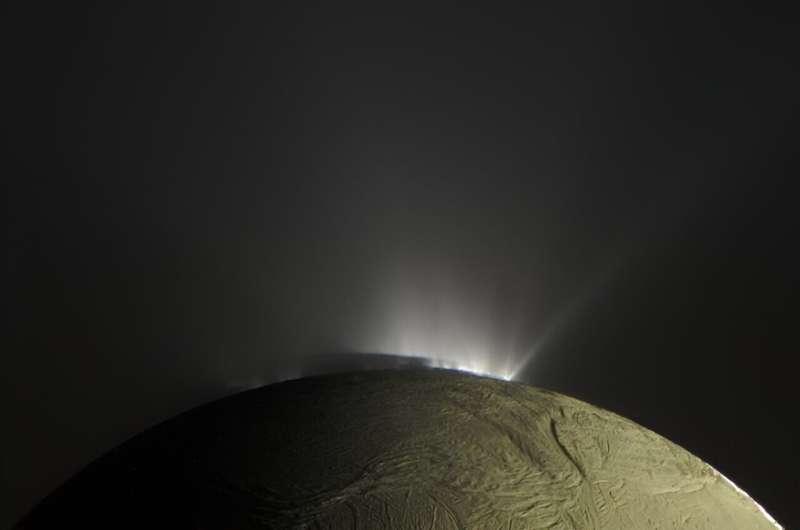This article has been reviewed according to Science X's editorial process and policies. Editors have highlighted the following attributes while ensuring the content's credibility:
fact-checked
trusted source
proofread
Cryovolcanism: Why study it? What can it teach us about finding life beyond Earth?

Universe Today has had the privilege of spending the last several months venturing into a multitude of scientific disciplines, including impact craters, planetary surfaces, exoplanets, astrobiology, solar physics, comets, planetary atmospheres, planetary geophysics, cosmochemistry, meteorites, radio astronomy, extremophiles, organic chemistry, and black holes, and their importance in helping teach scientists and the public about our place in the cosmos.
Here, we discuss the intriguing field of cryovolcanism with Dr. Rosaly Lopes, who is the Directorate Scientist for the Planetary Science Directorate and a Senior Research Scientist at NASA's Jet Propulsion Laboratory, regarding the importance of studying cryovolcanism, examples throughout the solar system, what cryovolcanism can teach us about finding life beyond Earth, exciting aspects of studying cryovolcanism, and advice for upcoming students who wish to study cryovolcanism.
So, what is the importance of studying cryovolcanism?
Dr. Lopes references Geissler (2015) and tells Universe Today, "My colleague Paul Geissler defined it well: 'The eruption of liquid or vapor phases (with or without entrained solids) of water or other volatiles that would be frozen solid at the normal temperature of the icy satellite's surface.'"
While we associate volcanism on Earth as being when hot magma erupts from the Earth's interior into a fiery blaze and melting everything in its path, cryovolcanism is the study of ice volcanism, as "cryo" is defined as "ice cold" or "frost." The term was first used in an abstract at the 1987 Geological Society of America (GSA) Abstract with Programs by Steven K. Croft, and has since been used to describe ice volcanoes throughout the solar system.
Additional terms used in the context of cryovolcanism include cryomagma and cryolava—comparable to magma and lava from traditional volcanoes—and cryovolcanic edifice—comparable to traditional shield volcanoes seen both on Earth and other planetary bodies (i.e., Mars and Venus). Therefore, what are some examples of cryovolcanism in our solar system?
Dr. Lopes tells Universe Today, "We see active cryovolcanism on Enceladus, and signs of past cryovolcanism on Titan, Europa, Ganymede, and even Io (SO2 rather than water)." Dr. Lopes elaborates more on active and past volcanism in a 2010 book chapter, as well.
The reason we see active cryovolcanism on Saturn's moon, Enceladus, is due to the large liquid water ocean it possesses beneath its icy crust, with NASA's Cassini spacecraft having not only imaged active plumes erupting from Enceladus's south pole "Tiger Stripes," but Cassini also flew through the plumes in March 2008, using its Ion and Neutral Mass Spectrometer (INMS) to identify water vapor, carbon dioxide, carbon monoxide, and organic materials, whose levels were higher than the Cassini team had hypothesized prior to the flyby.
Saturn's largest moon, Titan, is home to bodies of liquid methane and ethane across its surface due to the frigid surface temperatures of -182.55 degrees Celsius (-296.59 degrees Fahrenheit), whereas methane and ethane exist strictly as gases on Earth. Regarding evidence for past cryovolcanism on Titan, the Cassini spacecraft discovered Doom Mons in 2005 and Erebor Mons in 2007, with both currently being generally accepted as cryovolcanoes. Additionally, Cassini used its radar instruments in 2018 to identify topography on Titan that was identified as the "very best evidence" for a cryovolcano on Titan.
Like Enceladus, Jupiter's two Galilean moons, Europa and Ganymede, have exhibited significant evidence that they both contain interior liquid oceans beneath their icy crusts, and NASA's Europa Clipper mission is slated to launch this October to explore this icy world in detail once it arrives sometime in 2030. Additionally, the European Space Agency's Jupiter Icy Moons Explorer (JUICE) mission launched in April 2023 with the goal of studying Ganymede in detail and is currently scheduled to enter Ganymede's orbit sometime in late 2034.
Regarding evidence of past cryovolcanism on Europa, scientists postulated in 2020 that plumes observed to emanate from Europa could originate from directly within the icy crust. For Ganymede, specific surface features known as paterae have indicated "potential cryovolcanic regions," but scientists remain skeptical and have listed these features as something the JUICE mission should investigate further.
Additional worlds in our solar system that also exhibit past or current evidence of cryovolcanism include the dwarf planet, Ceres; Neptune's moon, Triton; the dwarf planet, Pluto and its moon, Charon; and other dwarf planets, as well. Therefore, with this plethora of worlds that exhibit current or past evidence of cryovolcanism within our solar system, what can cryovolcanism teach us about finding life beyond Earth?
Dr. Lopes tells Universe Today, "For life as we know it to exist, we need water and energy—cryovolcanism provides the heat (energy) and it is a way to bring material that may have biosignatures to the surface of bodies. If the material just stays in the ocean under an ice crust, it could be many decades before we are able to sample it."
Regarding the most exciting aspects of cryovolcanism that she has studied during her career, Dr. Lopes tells Universe Today, "Finding Doom Mons and Erebor Mons on Titan was very exciting, as they are the most convincing evidence we have that cryovolcanism happened on Titan."
Like the other scientific disciplines that Universe Today has explored, the field of cryovolcanism involves the collaboration of scientists from a multitude of backgrounds, including volcanology, planetary geology, physics, and computer science. Through this, scientists can create computer models of cryovolcanism based on existing data, along with using imagery from orbiters to confirm or update their models to ascertain the processes behind the cryovolcanism they have observed. Therefore, what advice can Dr. Lopes offer upcoming students who wish to study cryovolcanism?
Dr. Lopes tells Universe Today, "The physics of the process is still not well understood. Lab experiments are valuable. They should read the literature and figure out how to advance their understanding."
Provided by Universe Today



















